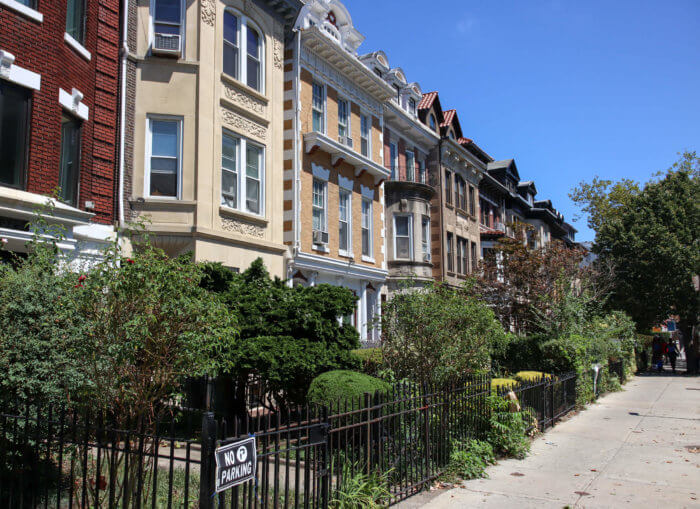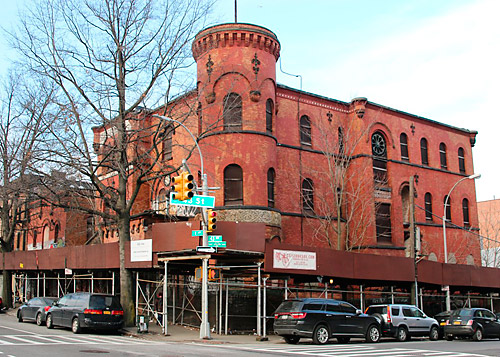Prospect Lefferts Gardens residents largely supported designating two rows of townhouses on Parkside Avenue as a historic district at a Landmarks Preservation Commission hearing Tuesday morning, saying the inconveniences caused by landmarking were a “worthwhile tradeoff” to avoid demolition of the more than 100-year-old homes.
The “remarkably cohesive and intact group” of 38 houses along Parkside Avenue between Flatbush and Bedford avenues were all built between 1909 and 1915 and include 20 two-family Kinko houses with separate entrances for each duplex unit, a style that originated in Brooklyn. The other 18 houses were constructed as single-family row houses and marketed as “easy housekeeping” homes at the time. The rows were designed by two of Brooklyn’s most prominent architects at the time, Benjamin Dreisler and Axel Hedman, for developers William A. A. Brown and Eli H. Bishop & Son.

A group of locals has been petitioning to have the houses landmarked since 2016, and the LPC in August voted to consider the proposed Melrose Parkside Historic District.
At Tuesday’s hearing, around half of the 14 speakers lived or had lived on the block, and 13 of them supported landmarking. Many shared similar fears about the fate of the houses without protection from the LPC, especially given the development happening in surrounding blocks.
Parkside Avenue local Michael Lent told commissioners how neighbors became aware of the threat of development in 2015, when developers “started buying homes and adjacent lots on other blocks, tearing them down and building new multifamily dwellings, often not in keeping with the neighborhood’s or block’s character. The dwellings torn down included wonderful old brick and stone homes,” he said.
Lent, who has lived in his house since 2000, said he was first attracted to the block because of “the beautiful historic homes, the diversity of the neighborhood and the welcoming neighbors we met,” adding there is a very strong sense of community on the block.
He said having to submit planned work on the houses to LPC for approval was a “worthwhile tradeoff” for the preservation of the character of the community. “Its architectural nature and historic nature is part of that character and is of vital importance,” he said.
Diana Lenhart, a real estate broker who has lived on the block since 2017, seconded that, saying “I would argue that the tradeoff for not landmarking the block is much more inconvenient and much more disruptive than going through a minor application process.”
Longtime block resident Cheryl Sealey said she had “atched a community decimated by overdevelopment, homes and adjoining blocks destroyed to make way for new and out of context development.” She told commissioners she did not want the houses on Parkside Avenue to suffer the same fate, adding that residents had fought “to maintain the integrity and character of their homes.”

Norma Williams, who bought her Parkside Avenue home with her husband in 1978, said she and her family are in total support of landmarking and that the block is unique in so many ways and she wants it to be preserved for future generations. Her grown children also wrote letters of support.
Brent Butler, who was raised on the block and whose mother still lives there, said he supports landmarking for a number of reasons, including that it would increase intergenerational equity and allow for the provision of city resources.
He said designation would enable residents to access resources to protect their homes, such as low interest loans to repair facades. “I would highlight my mother’s long desire to replace the roof and put a roof that was originally designed to be on our building as being a prohibitive cost, but something that she had for 40 years desired.”
However, not all residents at the hearing were in favor of designation. Kurt Flamer-Caldera wanted to clarify to the commissioners that the block association had not voted in favor of landmarking, and rather it was a group of members that were in favor. “It was a contentious issue and we decided to go separate ways,” he said.
“I and a number of other owners here on the block, who actually live on the block, are opposed to the idea of coming under the scrutiny and control of the historical requirements. It’s not that we want to change it or damage it, I think it’s just unnecessary,” he said.
Flamer-Caldera said development could be controlled with legal mechanisms such as deed restrictions and restrictive covenants, which would prevent demolition “without having to impose the much more extensive and frankly micro-managerial elements of the Landmark Preservation Commission’s guide books and regulations.”

He said when he and his wife bought their house on the block they did so because they “love the location, the history of the area, the quality of the building, and also the absence of a landmark; not because we want to see things demolished, because we’re very opposed to that, but we are opposed to the imposition of a bunch of requirements that invariably cost a whole lot more to implement.”
LPC staff member Gregory Cala said the agency received 15 additional letters: 11 from residents in support, one from the PLG Council in support, one that was in opposition and two that were undecided.
LPC Chair Sarah Carroll closed the hearing, thanking the speakers for their participation and informing “our review of this proposed designation”. She said the designation would come back for a vote “in the near future.”
This story originally appeared on Brooklyn Paper’s sister site Brownstoner.

























